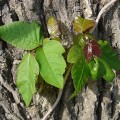The National Park Service and the Smithsonian Institution have announced a new partnership to share responsibility for selected National Park Service natural history collections, making them more readily available to researchers through the Smithsonian.
Collections will continue to be owned by the National Park Service but will be in the permanent custodial care of the Smithsonian Institution. The agreement formalizing the relationship was signed today by National Park Service Director Jonathan B. Jarvis and the Smithsonian’s Under Secretary for Science Eva J. Pell at the National Museum of Natural History.

National Park Service Director Jonathan B. Jarvis and the Smithsonian’s Under Secretary for Science Eva J. Pell sign a memorandum of understanding at the Smithsonian’s National Museum of Natural History. The partnership gives broader access to National Park Service collections through the Smithsonian’s care and management of them. (Photo: John Gibbons, Smithsonian)
“This agreement benefits science, the American people, and the long-standing and historic relationship between our two organizations,” said Jarvis. “Together we are building a collection that will become an extraordinary tool for the scientific community to study biodiversity, evolution, and the distinctive character of national park ecosystems.”
The Smithsonian echoed the significance of the new agreement. “Two venerable institutions long known for protecting the nation’s heritage, are now working together to enhance care and access to specimens that document the natural environment of our national parks,” said Eva Pell, under secretary for science at the Smithsonian.
Examples of National Park Service collections that the Smithsonian could curate under the new agreement are:
- 138 holotypes – a specimen described in scientific literature to establish a new species – that researchers in Great Smoky Mountains National Park in Tennessee and North Carolina have discovered and described over the past 14 years.
- From George Washington Memorial Parkway in Virginia, 3,000 vascular plant specimens representing 1,326 species, as well as a wide range of specimens from the Potomac River Gorge, including holotypes of shoreflies, caddisflies, and copepods (small crustaceans).





